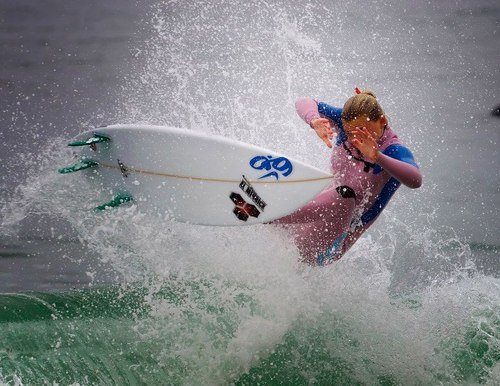Moving From Surfing Soft Tops to Short Boards
The real fun new aspirants to surfing think is what they see in films where experts ride the shorter surf boards.
Getting Started on Soft Top Surf Boards
Surfing is more difficult and tiring than experts make it appear. My new students always say the same things: this is more difficult and more tiring than I expected. And this is regardless of their fitness level or age.

Soft tops to short boards
One thing that makes surfing easier and less tiring is a high volume surf board. Shorter surf boards are harder to paddle, more difficult for catching waves, and more difficult to ride. The easiest wave to ride is the foam or broken wave that is close to shore. So new students need to learn the techniques on high volume boards near shore.
The techniques they learn are not amateurish. The same techniques used for beginners is what are used by experts. Because they are difficult on a short board, beginners need to learn them on a high volume board. This might be why snowboarders learn flips on a trampoline before they go off a 50′ jump.
The Process of Moving from High Volume to Low Volume Surf Boards
I start new students of all ages on a 9′ soft top board. When they have mastered balance, catching waves, and popping up on the board, I move them to an 8′ board. Unless they are skilled in the beginner techniques, the 8′ board will be too challenging to keep the sport fun. Fun is why we are in it, no?
On an 8′ board, new students can start to paddle out to ride bigger foam waves and start riding small real waves that break near shore. The real wave as it arcs provides the necessary power for a low volume shorter surf board to move. Catching an arcing wave requires timing, judgment, technique, and courage. The new surfer needs each of these facets to move forward.
Experts will say that waves are not measured in feet, but increments of fear. Once students feel how much power a wave contains, they are immediately respectful of their vulnerability. The way to move through vulnerability to confidence is mastering the techniques. Progressing slowly gives students the time to build skills and confidence.
Moving to lower volume boards should include shortening the length 6″ at a time and maintaining the volume of width and thickness. The shorter surf board should still be 21″ wide and 2.75″ thick to allow reasonable progress and confidence development.
For Surf Lessons in Oceanside, see Home Page

 Longboard Surfing Bliss in Oceanside!
Longboard Surfing Bliss in Oceanside! 
 Longboard Surfing Lessons in Oceanside – Are you ready to step into the world of classic, soulful surfing? Look no further! Our longboard surfing lessons in Oceanside are here to introduce you to the art of riding those iconic waves on a longboard. Get ready to experience the…
Longboard Surfing Lessons in Oceanside – Are you ready to step into the world of classic, soulful surfing? Look no further! Our longboard surfing lessons in Oceanside are here to introduce you to the art of riding those iconic waves on a longboard. Get ready to experience the…
 Surfing Lessons for Teens – Ride the Waves and Unleash Your Inner Water Warrior! Are you a teenager in Oceanside who’s ready to embrace the thrilling world of surfing? Look no further! We’ve got the ultimate surfing lessons tailored just for you. Join us for an…
Surfing Lessons for Teens – Ride the Waves and Unleash Your Inner Water Warrior! Are you a teenager in Oceanside who’s ready to embrace the thrilling world of surfing? Look no further! We’ve got the ultimate surfing lessons tailored just for you. Join us for an…
 Surf Lessons for Couples – Ride the Waves and Spark Some Romance! Are you and your significant other ready to embark on an unforgettable journey together? Picture this: you and your loved one, standing side by side on a sun-kissed beach, feeling the exhilaration of catching that perfect wave…
Surf Lessons for Couples – Ride the Waves and Spark Some Romance! Are you and your significant other ready to embark on an unforgettable journey together? Picture this: you and your loved one, standing side by side on a sun-kissed beach, feeling the exhilaration of catching that perfect wave…